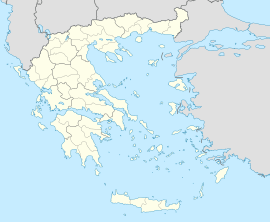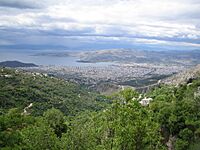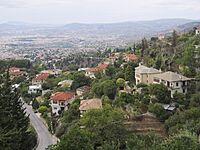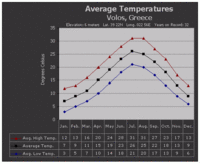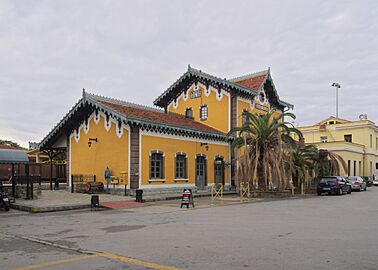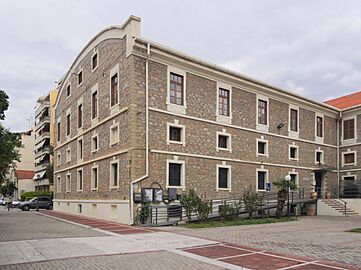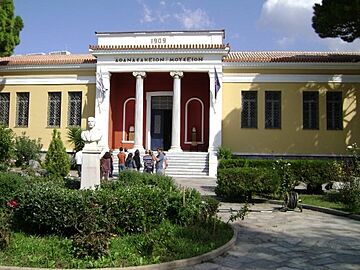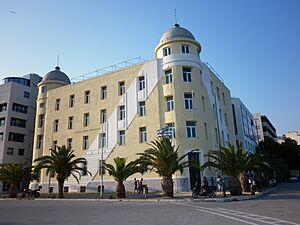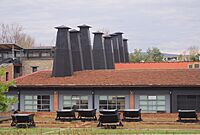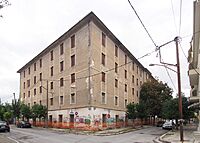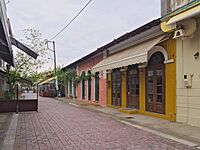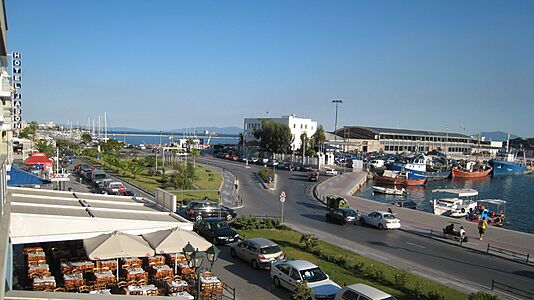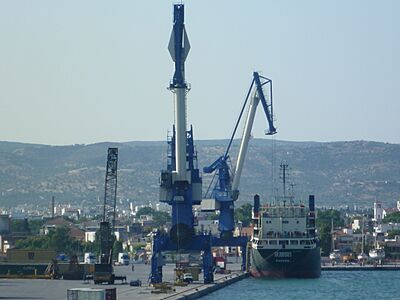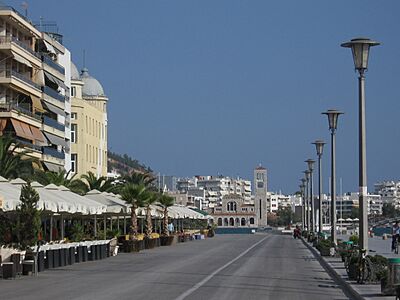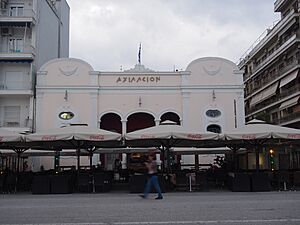Volos facts for kids
Quick facts for kids
Volos
Βόλος
|
||
|---|---|---|
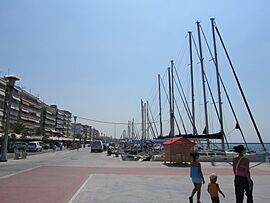
View to Volos' promenade and port
|
||
|
||
| Country | Greece | |
| Administrative region | Thessaly | |
| Regional unit | Magnesia | |
| Districts | 18 | |
| Area | ||
| • Municipality | 385.6 km2 (148.9 sq mi) | |
| • Municipal unit | 108.6 km2 (41.9 sq mi) | |
| Elevation | 15 m (49 ft) | |
| Population
(2021)
|
||
| • Municipality | 139,670 | |
| • Municipality density | 362.21/km2 (938.13/sq mi) | |
| • Municipal unit | 85,803 | |
| • Municipal unit density | 790.1/km2 (2,046.3/sq mi) | |
| Time zone | UTC+2 (EET) | |
| • Summer (DST) | UTC+3 (EEST) | |
| Postal code |
38x xx
|
|
| Area code(s) | 2421x | |
| Vehicle registration | ΒΟx (ended), ΒΒx (current use) | |
| Website | www.volos-city.gr | |
Volos (Greek: Βόλος [ˈvolos]) is a port city in Greece. It is located in the middle of the Greek mainland. Volos is about 330 kilometers (205 miles) north of Athens. It is also 220 kilometers (137 miles) south of Thessaloniki.
Volos is the main city of the Magnesia region. It is the only way for the large farming area of Thessaly to reach the sea. With about 85,803 people (in 2021), Volos is an important center for factories. Its port connects Europe and Asia.
Volos is one of Greece's newest port cities. Many of its buildings are modern. This is because strong earthquakes in 1955 damaged older ones. The city includes the areas of Volos, Nea Ionia, and Iolkos. Smaller towns nearby are also part of it.
The city's economy relies on making things, trading, services, and tourism. Volos is home to the University of Thessaly. It also hosts many events like conferences, exhibitions, and sports. Volos was part of the 2004 Olympic Games. It has also hosted other big sports events. In 2013, it hosted the 7th International Olympiad on Astronomy and Astrophysics.
Contents
- Exploring Volos's Location
- A Look at Volos's Past
- How Volos is Run
- Volos's Geography and Climate
- Volos's Architecture and Buildings
- Neighborhoods of Volos
- Learning in Volos
- Volos's Economy
- The Port of Volos
- Volos's Global Connections
- Volos's Culture
- Getting Around Volos
- Famous People from Volos
- See also
Exploring Volos's Location
Volos is built deep inside the Pagasetic Gulf. It sits at the foot of Mount Pelion. This mountain is famous in myths as the home of the Centaurs. The city spreads out on the flat land near Mount Pelion. It borders the town of Agria to the east. To the southwest, it borders Nea Anchialos. The city of Volos also includes these towns and many nearby villages. These include Makrinitsa and Portaria.
Volos is a major trading port in the Aegean Sea. It is one of the busiest after Piraeus and Thessaloniki. You can take ferries and hydrofoils from Volos. They connect to nearby Sporades Islands like Skiathos, Skopelos, and Alonissos. There are also connections to Lemnos, Lesbos, Chios, and Skyros.
A Look at Volos's Past
Ancient Times and Myths
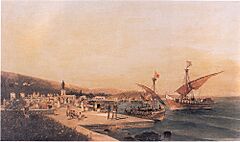
Modern Volos is built where three ancient cities once stood. These were Demetrias, Pagasae, and Iolcos. Demetrias was founded in 293 BC by King Demetrius Poliorcetes.
Iolcus is famous in Greek myths. It was the home of the hero Jason. He sailed from here on his ship, the Argo. Jason and his Argonauts went on a quest for the Golden Fleece.
Near Volos, you can find very old settlements from the Neolithic period. These are Dimini and Sesklo. Dimini has old walls and tombs from 4000 to 1200 BC. Sesklo has the oldest acropolis (a high, fortified part of a city) in Greece, from 6000 BC. In western Volos, the Kastro/Palaia mound has remains of a Bronze Age settlement. This includes a Mycenaean palace. Here, ancient writing tablets called Linear B have been found.
Volos in the Middle Ages
In early Byzantine times, Iolcus was still known. But for most of the Middle Ages, Demetrias was more important. A Slavic tribe called the Belegezites settled here in the 7th century.
Volos is first mentioned again in 1333. It was called "Golos" then. It was one of the cities captured by the Byzantine general John Monomachos. The name "Golos" likely comes from a Slavic word meaning "barren" or "seat of administration." The name "Volos" as we know it today first appeared in 1540.
The walls of medieval Golos followed the lines of ancient Iolcus. Many old city parts have been found in the medieval fortress.
Like the rest of Thessaly, Volos came under Serbian rule in 1348. After some changes in rulers, Thessaly returned to Byzantine rule for 20 years. Then, in 1393, the Ottoman Empire took over under Sultan Bayezid I.
Ottoman Rule and Greek Independence
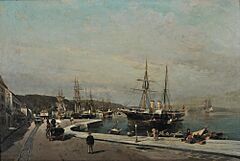
The Ottomans took full control of Volos in 1423. They called the city "Quluz." They made the city's defenses stronger. They also brought Muslim settlers from Anatolia. The local Christian people moved to the slopes of Pelion mountain. From this time, Volos became the main settlement in the Pagasetic Gulf.
The city started to grow outside its walls in the late 1500s and early 1600s. This was because trade was growing. The city had a famous market twice a week. The port also started to develop. In 1665, the Venetians captured the fortress during the Cretan War. But the Ottomans soon got it back and made it stronger.
In May 1821, the Greek Revolution began. Greek rebels from Mount Pelion tried to capture the fortress but failed. In 1827, the Greek fleet, led by Frank Abney Hastings, captured Ottoman ships in the harbor. They forced the Ottoman soldiers to leave the fortress. Greece claimed Volos as its own. But the Treaty of Constantinople (1832) set the border south of Volos. Volos finally became part of the Greek Kingdom in November 1881. This happened along with the rest of Thessaly.
Modern Volos's Growth
When Volos joined Greece, it had only about 4,900 people. But it grew very fast. Many merchants, business people, craftspeople, and sailors moved there. In the 1920s, many refugees came to Volos. They were mostly from Ionia, but also from Pontus, Cappadocia, and Eastern Thrace.
Volos had a lively Jewish community in the early 1900s. Their numbers grew but then fell. During the Axis occupation of Greece in World War II, the local rabbi, Moshe Pessach, and Greek officials helped save about 700 Jewish people from being sent to Nazi camps.
After attacks by Italian and German forces in World War II, many people moved to Pelion villages. When the Italians left in 1943, they left behind food and weapons. These were taken by resistance fighters to hideaways. In return, German soldiers burned down almost the entire village of Milies on October 4, 1943. They also executed 25 men.
Volos is also known for its special small dishes called mezedes. It is also famous for a strong alcoholic drink called tsipouro.
In September 2023, the city of Volos experienced massive flooding from heavy rain.
How Volos is Run
The city of Volos was formed in 2011. It combined nine smaller areas into one big municipality. These areas became "municipal units." They include:
- Agria
- Aisonia
- Artemida
- Iolcos
- Makrinitsa
- Nea Anchialos
- Nea Ionia
- Portaria
- Volos
The whole municipality covers about 385.6 square kilometers (148.9 sq mi). The main municipal unit of Volos is 108.6 square kilometers (41.9 sq mi).
Volos's Geography and Climate
Volos is the main administrative center of the Magnesia region. Natural barriers like rivers separate many parts of the city.
Three main rivers flow from Mount Pelion (which is 1,610 meters or 5,282 feet high). They cross the city and flow into the Pagasetic Gulf to the west. The Anavros river divides the Nea Demetriada area from the rest of the city. The Krafsidonas river is a major river that flows through the city. It acts as a green space and marks the border between Volos and Nea Ionia. Xirias (Ξηριάς) is the largest stream in the Volos area. It flows through the Nea Ionia municipal area.
Volos's Weather
Volos has a hot-summer Mediterranean climate. This means it has warm, dry summers and mild, wet winters. Temperatures are not usually too high or too low. The humidity is fairly low, which is good for outdoor activities.
It rains about 89 days a year. Thunderstorms happen sometimes, more often in warmer months. Snow falls almost every year, but it usually does not stop daily life. Mount Pelion affects the city's weather. It blocks some winds, so Volos gets less rain than the eastern side of the mountain. Average temperatures have gone up a little in recent years.
| Climate data for Volos (1958–1983) | |||||||||||||
|---|---|---|---|---|---|---|---|---|---|---|---|---|---|
| Month | Jan | Feb | Mar | Apr | May | Jun | Jul | Aug | Sep | Oct | Nov | Dec | Year |
| Record high °C (°F) | 23.0 (73.4) |
24.7 (76.5) |
26.0 (78.8) |
34.0 (93.2) |
35.2 (95.4) |
37.8 (100.0) |
44.2 (111.6) |
39.6 (103.3) |
36.8 (98.2) |
30.4 (86.7) |
27.2 (81.0) |
24.4 (75.9) |
44.2 (111.6) |
| Mean daily maximum °C (°F) | 11.3 (52.3) |
12.9 (55.2) |
15.0 (59.0) |
19.4 (66.9) |
24.0 (75.2) |
28.5 (83.3) |
31.0 (87.8) |
30.6 (87.1) |
27.0 (80.6) |
21.7 (71.1) |
17.3 (63.1) |
13.2 (55.8) |
21.0 (69.8) |
| Daily mean °C (°F) | 7.8 (46.0) |
9.0 (48.2) |
11.3 (52.3) |
15.4 (59.7) |
20.1 (68.2) |
24.6 (76.3) |
27.0 (80.6) |
26.6 (79.9) |
22.9 (73.2) |
17.7 (63.9) |
13.3 (55.9) |
9.5 (49.1) |
17.4 (63.3) |
| Mean daily minimum °C (°F) | 4.5 (40.1) |
5.4 (41.7) |
7.3 (45.1) |
10.5 (50.9) |
14.9 (58.8) |
19.0 (66.2) |
21.3 (70.3) |
21.2 (70.2) |
17.9 (64.2) |
13.6 (56.5) |
9.8 (49.6) |
6.3 (43.3) |
12.6 (54.7) |
| Record low °C (°F) | −8.2 (17.2) |
−7.8 (18.0) |
−3.2 (26.2) |
1.8 (35.2) |
6.2 (43.2) |
11.6 (52.9) |
14.0 (57.2) |
14.8 (58.6) |
9.2 (48.6) |
1.4 (34.5) |
0.6 (33.1) |
−6.0 (21.2) |
−8.2 (17.2) |
| Average precipitation mm (inches) | 58.4 (2.30) |
35.4 (1.39) |
40.5 (1.59) |
27.3 (1.07) |
32.5 (1.28) |
22.5 (0.89) |
15.1 (0.59) |
10.9 (0.43) |
45.0 (1.77) |
51.8 (2.04) |
52.2 (2.06) |
47.2 (1.86) |
428.8 (16.88) |
| Average precipitation days (≥ 1.0 mm) | 10.5 | 9.7 | 9.9 | 8.2 | 6.6 | 5.2 | 2.8 | 2.7 | 5.3 | 8.1 | 10.1 | 10.1 | 89.2 |
| Average relative humidity (%) | 72.7 | 70.0 | 69.5 | 65.7 | 65.0 | 61.2 | 58.1 | 60.1 | 65.5 | 70.4 | 74.0 | 73.7 | 67.2 |
| Mean monthly sunshine hours | 102.7 | 109.8 | 150.5 | 200.8 | 260.3 | 290.2 | 337.1 | 320.1 | 240.6 | 167.8 | 122.0 | 100.0 | 2,401.9 |
| Source: Meteovolos | |||||||||||||
Volos's Architecture and Buildings
Two famous churches in Volos are St. Nicholas and St. Constantine and Helen. They are on the promenade. Architect Aristotelis Zachos designed them. Volos once had many old mansions. Most were destroyed by the 1955 earthquakes. Today, some have been saved and fixed up. They are now used for public purposes.
As the new city grew, a style called neoclassicism became popular. Public buildings followed this style. Private homes of rich merchants were also very fancy. Here are some examples:
- The 3-story Hotel de France (1894)
- Old Tobacco Factory of Matsaggos (1890)
- Yellow Tobacco Warehouse (1926)
- The National Bank (1895)
- The Bank of Athens (1903), now the University of Thessaly library
- The Achillopouleion Hospital (1901)
- The Archaeological Museum of Volos, Athanasakeio (1909)
- The Agricultural Bank (1909)
- The Cine-theater Achilleion (1925)
- The Aegli Hotel (1927)
- The Bank of Greece building (1935)
- The Railway Station of Volos
Neighborhoods of Volos
Volos has several different neighborhoods. Here are some of the main ones:
- City Centre (50,249 people)
- Agios Nikolaos
- Kallithea
- Hiliadou
- Oxygono
- Epta Platania
- Agios Konstantinos
- Anavros
- Agios Gerasimos
- Agios Vasileios
- Palia
- Analipsi
- Metamorfosi
- Karagats
- North (9,247 people)
- Agia Paraskevi
- Agios Georgios
- Aerokampos
- East (11,514 people)
- Nea Dimitriada
- North-West (33,815 people)
- Nea Ionia
- Melissatika
- Fytoko
- South-West (20,403 people)
- Agii Anargyri
- Neapoli
- Aivaliotika
- Pefkakia
- Alykes
Learning in Volos
Volos is home to the main campus of the University of Thessaly. This university was started in 1984. It is a very important place for education in central Greece. The university has many departments in Volos. These include engineering, humanities, social sciences, and agricultural sciences. They help the city grow in education, economy, and culture.
The university buildings are in different parts of the city. The engineering departments are at the “Pedion Areos” Campus. The humanities and social sciences are in the city center. The agricultural sciences are in a renovated building in Fytoko. Many students from other countries also come to study here through programs like Erasmus.
Besides the university, Volos has many schools for younger students. There are 56 kindergartens, 51 primary schools, 18 junior high schools, and 13 senior high schools.
Volos's Economy
Volos is one of the most industrial cities in Greece outside of Athens and Thessaloniki. This is because of its great location and its port. The city is known for making steel. Three big steel companies have factories here. These are METKA, SIDENOR, and Hellenic Steel Industry. They are in Volos and nearby Almyros.
AGET Heracles, part of the Lafarge group, has one of the world's largest cement factories here. It even has its own private port next to the city. Volos is also active in research. It hosts the Institute of Bio-Economy and Agri-Technology (iBO). This is one of the five Institutes of the Center for Research and Technology – Hellas (CERTH).
The Port of Volos
The port of Volos is built on the site of the ancient city of Iolkos. In Greek mythology, this is where the hero Jason built his ship, the Argo. From here, he sailed with his crew to Colchis to find the Golden Fleece.
The new port was built in 1893. It was very important for the area's industrial growth. Today, Volos has the third-largest cargo port in Greece. It ships farm products and factory goods.
Ferries and fast "flying dolphins" leave daily from Volos. They connect the city to the Sporades islands: Skiathos, Skopelos, and Alonissos. Many cruise ships also visit Volos. In 2015 and 2016, over 100 cruise ships arrived. They brought more than 100,000 visitors.
Volos's Global Connections
Volos has always been important for business and trade in Thessaly and Central Greece. This is because its port is in a key location between Athens and Thessaloniki.
International Offices
Several European countries have opened consulates (offices that help their citizens and promote trade) in Volos. These include:
Sister Cities
Volos is twinned with several cities around the world. This means they have special friendly relationships.
 Antofagasta, Chile
Antofagasta, Chile Batumi, Georgia
Batumi, Georgia Le Mans, France
Le Mans, France Pleven, Bulgaria
Pleven, Bulgaria Rostov-on-Don, Russia
Rostov-on-Don, Russia Smederevo, Serbia
Smederevo, Serbia Sochi, Russia
Sochi, Russia
Volos's Culture
The area around Volos has a very rich history. The first signs of culture in Europe were found here in the Neolithic period. The villages of Sesklo and Dimini show this ancient past.
Close to Volos, you can also find ancient Demetrias. This town was built by Dimitrios Poliorkitis. Today, its ancient theater is still standing. There are also old findings from early Christian times in Nea Anchialos. You can also visit the walls of Volos's old castle.
Volos is a city with many different Greek traditions. Its growth in industry brought many people to live there. This economic growth also led to cultural and social development. In 1894, Volos got its Municipal Theater. Later, it got a Gymnastics Club. In 1908, Volos became home to the first Labour Union in Greece.
After 1922, many people came to Volos after the Asia Minor Catastrophe. This mix of new and local people greatly shaped the city's culture. You can still see this influence in the food, music, sports, and social life today.
Today, Volos has many museums and art galleries. It is also a very attractive city for tourists. This is because it combines the Pagasetic Gulf with Mount Pelion.
Volos was considered to be the European Capital of Culture for 2021.
Museums and Art Galleries
- Archaeological Museum of Volos
- Volos Natural History Museum
- Modern History Museum of Volos City
- Giorgio de Chirico Art Centre
- Thessaly Railway Museum, at the Railway Station of Volos
- The Rooftile and Brickworks Museum N. & S. Tsalapatas
- Entomological Museum of Volos
- Theofilos Museum, Anakasia (showing works by artist Theofilos Hatzimikhail)
Local Food and Drinks
One of the most famous things about Volos is its traditional drink, tsipouro. This drink is usually served with small seafood dishes.
Some other local specialties include:
- Boubari
- Spetzofai
- Melachrini (a dessert)
- Spoon sweets
- Tsipouro (a drink)
Sports in Volos
Volos is located by the sea, which makes it great for water sports. It has a strong history in rowing and sailing. The city also has swimming pools for swimming and water polo. Volos has clubs and facilities for many sports. These include football, basketball, volleyball, tennis, and horse riding. The most popular clubs are Olympiakos Volou and Niki Volou. They have done well in football and helped the city's sports and culture.
| Club | Founded | Sports | Achievements |
|---|---|---|---|
| Niki Volou | 1924 | Football, Basketball and other sports | Played in A Ethniki football |
| N.C. Volos-Argonauts | 1932 | Water Polo | Played in A1 Ethniki women |
| Olympiakos Volou | 1937 | Football, Basketball and other sports | Played in Europa League, A Ethniki football, won national title in women's basketball |
| Hippotis equestrian club | 2002 | Horse riding | Competes in national events |
| Volos 2004 | 2004 | Football | Played in A Ethniki women |
| Volos F.C. | 2017 | Football | Plays in A Ethniki football |
Because of its sports traditions, Volos was one of the five cities that hosted the 2004 Summer Olympics.
Since 2004, Volos has hosted many important sports events. These include the European Championship of Artistic Gymnastics in 2006. It also hosted the FIBA European Youth Championship in 2015, where Greece won the gold medal. The finals of the Greek Football Cup were held here in 2007 and 2017.
Getting Around Volos
You can reach Volos by all types of land transport. The International Airport of Central Greece in Nea Anchialos connects the city to other countries. The Port of Volos connects to the islands, especially the Sporades, and some places in Pilio.
Roads and Highways
Volos is connected to northern and southern Greece by the E75 Highway. This road is also known as PATHE. Another highway, the E65, will connect Volos to Western Greece and the port of Igoumenitsa. This will happen when that part of the E65 is finished.
Airport Access
The city of Volos and central Greece are connected to the rest of Greece and Europe by the Nea Anchialos National Airport. This airport has the second-longest commercial runway in Greece. Only Eleftherios Venizelos has a longer one.
Volos was the first city in Europe to have seaplane services. Argo Airways, based in Volos, connects Volos with Skiathos, Skopelos, Alonissos, Athens, and Thessaloniki by seaplane.
Train Services
Today, Volos has direct train lines to other parts of Greece. The railway station also has facilities to maintain trains. Volos is directly connected to Athens once a day. It has two connections to Thessaloniki daily. There are 15 connections a day to Larissa.
In the past, Volos had train lines of three different sizes. There was a narrow-gauge line to Kalampaka. There was a standard-gauge line to Larissa. And there was a very narrow-gauge line to Pelion. You can still see parts of the tracks where all three sizes used to be. Today, the Pelion railway line runs for tourists. It operates every Saturday, Sunday, and public holiday from mid-April to the end of October. In July and August, the train runs every day.
Famous People from Volos

Mythological Figures
Modern Notable People
- Giorgio de Chirico, painter (1888–1978)
- Vangelis, composer (1943–2022)
- Kostas Papaïoannou, philosopher (1925–1981)
- John Argyris, engineering pioneer and professor (1913–2004)
- Fotis Kouvelis, politician
- Dimitrios Trichopoulos, medical doctor and professor
- Georgios Kartalis, politician (1908–1957)
- Yorgos Foudoulis, musician and composer (1964)
- Moshe Pesach, rabbi of Volos and Chief Rabbi of Greece
- Lavrentis Mahairitsas, musician and songwriter (1956-2019)
- Artemis Alexiadou, linguist (1969)
- Yorgo Moutsiaras, orchestral conductor (1976)
- Apostolia Zoi, singer (1980)
- Andromache (Mary) Mavroyeni Papanicolaou, (1890-1982), wife of George N. Papanicolaou, MD, PhD and first cytotechnologist
Athletes from Volos
- Vasileios Polymeros, rower, Olympic medalist (1976)
- Nikolaos Skiathitis, rower, Olympic medalist (1981)
- Olga Vasdeki, triple jumper (1973)
- Spyridon Vasdekis, long jumper (1970)
- Paraskevi Tsiamita, triple and long jumper (1972)
- Nikos Boudouris, basketball player (1971)
- Panagiotis Liadelis, basketball player (1974)
- Athanasios Kostoulas, football player (1976)
- Efthalia Koutroumanidou, beach volleyball player (1982)
- Evanthia Makrygianni, synchronized swimmer (1986)
- Christos Volikakis, track cyclist (1988)
- Adam Tzanetopoulos, football player (1995)
See also
 In Spanish: Volos para niños
In Spanish: Volos para niños



